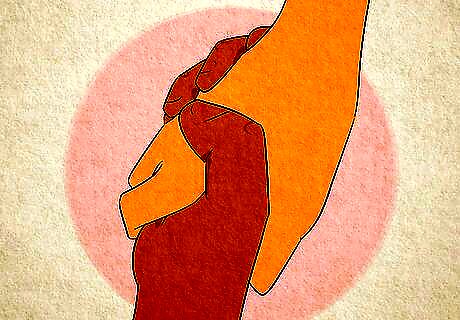
views
Recognize the signs of an avoidant attachment style.

Knowing your partner's attachment style helps you understand their behavior. According to attachment theory, people’s attachment styles come from their experiences in early childhood. If your partner wasn’t able to feel like they could rely on their caregiver, they may fear relying on anyone as an adult. Your partner may have an avoidant attachment style if they: Withdraw when you try to get close to them Accuse you of being needy Prefer fleeting relationships to intimate ones Are uncomfortable expressing emotions Believe things like, “I don’t need anyone but myself.”
Affirm their emotional experience.

Telling your partner you understand their needs helps them trust you. An avoidant partner might feel guilty over their inability to give you the attention and support you need. By reassuring them that you can empathize with how they feel, they can feel more at ease with you, which can help them feel more secure in the relationship and shed some of their avoidant qualities. You might say something like: “I know that your personal independence is important to you, and I won’t put too much pressure on you to make a commitment to me.” “I realize that you need your personal space, and I just want to say that I’m here for you when you want to spend more time together.” “I know this relationship can feel stressful for you. I get how you feel, but I still care for you and am happy you’re in my life.”
Respect their personal space.

For your partner, personal space means security. People with avoidant attachment styles need space in order to feel independent and safe. Even though it may be tough to accept, for your partner, feeling like they can rely on themselves is an important part of feeling like they can manage a relationship at all. When your partner is taking some space for themselves, do your best not to text or call them too frequently. This can make them feel stifled. Your partner might also appreciate you giving them the opportunity to take some space. Tell them something like, “I love spending time with you, and would love to keep hanging out. But if you want to go back home, I understand.”
Encourage them when they show vulnerability.

Positive feedback lets your partner know they’re on the right track. When an avoidant person hears that their efforts to make themselves more available are appreciated, they’re much more likely to continue doing this in the future. Offer positive feedback by saying something like: “I know you like your alone time, but it means a lot to me that you came today.” “Thanks for joining me for dinner. It makes me really happy to spend time with you.” “I’m grateful that you opened up to me. It’s really important to me that you feel comfortable doing this.”
Be a reliable source of support.

Show your partner they don’t have to just rely on themselves. By being there for your partner when they need you, you can show them that you’re someone they can count on. As they learn that they can trust you, they may be able to shift their attachment style from avoidant to one with more secure tendencies. Try doing things like: Listening to your partner when they feel stressed or anxious, and affirming that you care about them. Reliably helping your partner out with tasks like transportation, home maintenance, or daily errands. Noticing when your partner is struggling with something at work or school, and following through when offering them help.
Practice intimacy building exercises.

A few simple exercises can help your partner feel more secure. Studies have shown that activities like partner yoga promote feelings of security in people with avoidant attachment styles. Asking intimacy-building questions is another possible way to build feelings of safety in the relationship. Try asking your partner questions like the following ones, and be sure to respond to them yourself: “What does friendship mean to you?” “What is your most treasured memory?” “What is your most terrible memory?” “When did you last cry?” “If your house was to burn down, and everyone who had been inside was safe, what would be the one thing you would rescue from the fire?”
Use respectful language.

Communicating respectfully with your partner makes them feel safe. When talking to someone with an avoidant attachment style, try your best to not place too much blame on them, or speak to them with accusatory language. Often, their first response might be to withdraw from you, which can hurt your relationship. Try using “I-statements” like: Instead of saying, “You’re selfish,” say, “I feel like my needs sometimes aren’t being met.” Instead of saying, “You don’t care about me,” say, “I feel like I want to be a higher priority in your life.” Instead of saying, “You treat me terribly,” say, “I feel hurt and sad when you cancel plans at the last minute.”
Work out good compromises.

Accepting each other’s limitations is crucial for the relationship. Unlike people with an anxious attachment style, avoidant partners tend to not expect perfection in any relationship. They understand that good relationships are based on compromise, and working out these compromises can key your relationship strong. You can offer to compromise by saying something like: “I know that you don’t want to spend time together every day. How about if we meet twice a week instead?” “I realize that it’s tough for you to open up with me about your stress. Why don’t we spend time doing something that you enjoy, and then we talk about what’s on your mind this evening?” “I know that you love taking trips by yourself on the weekends. Why don’t we spend every other weekend together, so that you can still have some time to yourself?”
Set healthy boundaries.

Let your partner know their obligations in your relationship. Every relationship requires each partner to meet their responsibilities to their counterpart, including relationships with an avoidant partner. There’s no need to tolerate being disrespected in your relationship, and making your boundaries clear can prevent this from happening. Say something like: “I know that you need space, but calling me clingy or needy hurts me. I need you to speak to me with more respect.” “When you cancel plans, it’s important to me that you tell me at least 3 hours in advance unless it’s an emergency. I need you to respect my time.” “When you decide to go out of contact, please let me know that you’re taking time for yourself. I won’t pressure you to respond immediately, but I don’t like worrying about you.”
Cultivate your own independent interests.

Independence is healthy in every relationship. Spending time pursuing your own hobbies, interests, and goals by yourself can help you cope with having an avoidant partner who might not always be around. By working on your own self-growth, you can put yourself in a position where you enjoy your partner’s company, but don’t need it to manage your own life. Having independent interests doesn’t mean you have to do them alone. If you have a network of friends or family, you can spend time developing these relationships, rather than rely solely on your partner for your needs.
Work on resolving your own anxieties.

Try your best to avoid placing responsibility on your avoidant partner. For people with an avoidant attachment style, it’s easy to feel emotionally burdened by their partner. Try to distinguish between when your avoidant partner is failing to meet their obligations to you and when it’s your own anxieties speaking. You should know that they are not able to understand emotions well. By taking on an avoidant attachment style, they try to minimize their emotions and the emotions of others. They may have learned this style from their parents. Although not being able to rely on your avoidant partner to support you emotionally can be really difficult, remember that there are other resources available to you until your partner feels more secure. If you’re feeling anxious about your relationship, try talking to a friend that you can trust. They might be able to give you an outside perspective on your relationship dynamics. Talking to a therapist can be a great way to feel more confident in the relationship. If you feel like you have an anxious attachment style, a therapist can help you navigate these feelings before you confront your partner.
Encourage them to seek professional support.

With help, overcoming an avoidant attachment style is possible. Recommend to your partner that they see a therapist who specializes in attachment theory. A professional can give them guidance on how they can shift their attachment style to a more secure one. If therapy isn’t an option, try suggesting that your partner read more about their attachment style. This kind of self-knowledge can help them overcome their avoidant tendencies.


















Comments
0 comment